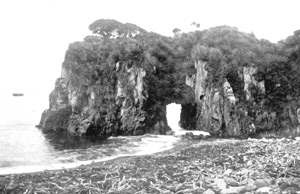
| Glasgow Digital Library | Voyage of the Scotia | BRUCE | PEOPLE | SHIP | ANTARCTIC | INDEX |
|---|

Gough Island is 3,200km (2,000 miles) from Cape Horn, 2,400km (1,500 miles) from the Cape of Good Hope and 320km (200 miles) from Tristan da Cunha. The island is 12km (eight miles) from west to east and rises to 1,330 metres (4,380 feet): almost as high as Ben Nevis. A very remote island, it had been ignored by past scientific expeditions, with most visits having come from whalers.
The island had been discovered by Diego Alvarez of Portugal in the sixteenth century. Captain Gough thought he had discovered the island in 1731, not realising it was Alvarez's island. The scientists from Scotia were the first to scientifically explore the island.
Gough Island was free from ice and snow (temperature 14°C), so the scientists could enjoy the grasses and flowers of this 'green' island. Cascades of water, narrow steep glens, buckthorn trees, tussock grass (similar to the Falkland Islands), mosses and ferns, wild celery - all these were catalogued. Vegetation was very similar to other islands in the area and to those in the Indian Ocean. Green and orange finches (similar to those on Tristan da Cunha) and black and scarlet water hens were found. The rocks were mainly of volcanic origin with lava flows, dykes and faulting.
'Have made bathymetrical survey of 4,400 miles of ocean, sounding and trawling in 2,660 fathoms, left Mossman and four others in Scotia Bay, South Orkneys, discovered great ice barrier 74ºS 17-28ºW, visited Gough Island, experienced bad weather, arrived in good condition, all well. Bruce.'
| Glasgow Digital Library | Voyage of the Scotia | BRUCE | PEOPLE | SHIP | ANTARCTIC | INDEX |
|---|